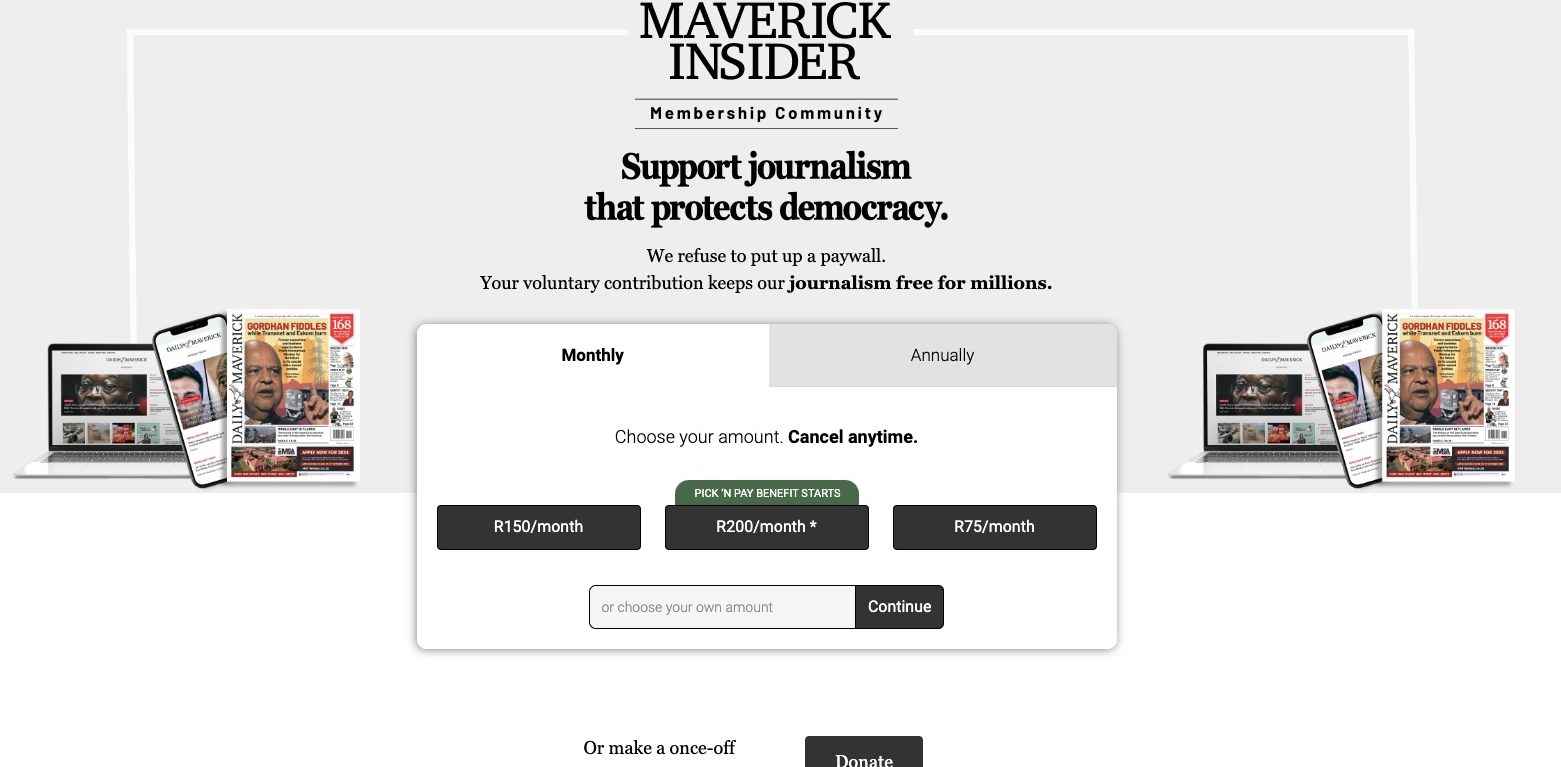
Newsletter
Newsletter
The membership model of South Africa’s Daily Maverick has delivered on its years-long search for sustainability.
15th November 2024

By Kevin
South Africa is a challenging place for journalism. Unemployment is roughly 30% for adults and more than 60% for young people. For 10 to 12 years, the country experienced almost four to six-hour power cuts every day because of rampant corruption, including theft and sabotage at the state power company under President Jacob Zuma.
“How are you going to grow an organisation in such a challenging market context?” asks Styli Charalambous, the Daily Maverick’s co-founder, CEO and publisher. After years of trying various business models, they found the answer in membership.
Membership is 40% of the revenue at the Daily Maverick and “continues to have a healthy growth rate”. The model has become their financial and editorial foundation, allowing them to grow from a scrappy five-person start-up to over 100 staff members.
If you’re keen to discuss membership strategies and proven tactics to increase customer lifetime value, join our Mobile Matters community to speak with publishers like you. The community is a place to meet other publishing professionals working in mobile and discuss common challenges and solutions.
Launching in 2009, the digital news outlet launched in an era of optimism in South Africa. The country was about to host the FIFA World Cup. The country was stepping out onto the world stage. Daily Maverick wanted to be the “digital go-to player that was going to disrupt the local [media] oligopoly”.
They went to market before the media industry was decimated by the rise of the global digital platforms that siphoned audience attention and advertising revenue from traditional players. The challenges facing the media industry in many countries were compounded in South Africa by political shocks created by Jacob Zuma’s election as president, which took place the year they launched. “He took the country down this path of massive corruption of the state and state organs and just derailed the whole democratic project,” Styli said.
Political corruption, the country’s economic malaise plus broader pressures on the business of journalism “combined to accelerate…the decimation of the industry,” he said, adding, “We’ve lost about 70% of our colleagues since we started in ‘09.”
In practice, it is eight times more difficult to operate a journalism business in South Africa than in Norway, according to findings from the News Sustainability Project by the Google News Initiative and FT Strategies. The project generated a sustainability score for countries based on factors such as the market context, press freedom, access to data and technology as well as economic factors such as income and cost of bandwidth. Their report, released in June 2023, found Norway had a score of 78 while South Africa only eked out a 10.
Facing these challenges meant the Daily Maverick spent many years looking for a business model to support their independent journalism. It launched in 2009 as an ad-supported for-profit organisation. “That clearly was not enough,” Styli said. They pivoted to being a non-profit with the hope that they could tap into philanthropy and grants, but that also didn’t provide enough income to support the business.
This was despite a ground-breaking and country-remaking investigation – the Gupta Leaks – which they refer to as South Africa’s Watergate and helped lead to Zuma’s ouster as president. Daily Maverick and other partners analysed gigabytes of leaked emails and documents that outlined how the Gupta brothers had “cosied up” to Zuma to direct taxpayer cash to their network of companies.
Looking for answers, Styli toured major media in North America, visiting the New York Times, the Washington Post and National Geographic. A common theme emerged. Those publishers that were the most optimistic had “made significant inroads into reader revenue programmes,” he said.
Putting up a hard paywall seemed antithetical to their mission, but as Styli was looking for answers, he came across a research paper about membership models for news organisations. The model did not just show promise to meet their financial needs, it was also consistent with “everything we stand for”.
For him, reader revenue operates on a continuum from subscriptions to donations, with membership in between. “At the heart of membership is a community of people joining a cause. People being part of something,” he said. Key to membership and this sense of connection is engaged journalism “where people feel a part of it”.
Daily Maverick’s model is similar to public media in the US: It is voluntary and they do not restrict access to their journalism. However, members receive other benefits including a behind-the-scenes newsletter and live events.
They designed the membership model and then decided to test it with a donation MVP when they changed their CMS. They had no expectations, but within minutes, they had their first donors. That was the validation of the concept, and they launched it.
Styli said the model has been a Trojan horse to seed engagement journalism techniques into the newsroom. “That has helped us become better at what we do, and that has fueled our growth.”
Engagement journalism has been distributed across editorial teams and baked into their business. When people join, they ask new members what their superpower is, and they add that to a database so that they can contact them, either for comment or as a source for their stories. When they needed a drone pilot, they found one who was a member. They found members who were on the president’s advisory council during the COVID-19 pandemic. One of the top constitutional lawyers in the country, who is a member, suggested a panel for an event and ended up being the moderator.
They hired one of their first members to be their community manager, who now serves as chief growth officer. A mental health counsellor who was a member first wrote mental health columns for the Daily Maverick before becoming their in-house mental health counsellor. “There are all these beautiful examples of how this community is more than people who are supporting us financially,” he said.
Engaged journalism techniques have delivered results. They have a newsletter called “Your Questions Answered” with a distribution list of 80,000 to 90,000 people that allows people to ask questions. They are bucketed into themes and answered by Daily Maverick staff, a minister or an expert. During the recent elections, they saw an open rate of 85 or even 90%, Styli said.
As Pugpig has found in surveying publishing leaders, retention and increasing customer lifetime value are top of mind, and Daily Maverick provides one model for achieving these goals. The South African publisher has a high customer lifetime value because “after three years, 85% of people who start as a member are still there”.
“The quality and the value that our journalism was creating for society got us going, and then we developed these membership and community skills on top of that to keep us growing,” he said.
The membership strategy is becoming increasingly sophisticated as they learn about behavioural nudges that build on the enthusiasm of early adopters and brand advocates who will get tattoos of your logo, he said.
Their site is powered by WordPress and a few years ago they migrated to WordPress VIP. In doing so, they cleaned up five years of code, which improved the performance of the site, even before the migration. They have since moved from WordPress VIP back to AWS.
Editorially, they also implemented an audience-centric key themes model. These two strategic moves unlocked a new phase of growth. “We’re between three and four times bigger, in terms of audience reach, than we were three years ago,” he said, adding that it bucked a trend of declining digital audiences publishers have seen in the rest of the world.
They also have an app that one of their members developed for them. As for many publishers, their app serves their most engaged users, who are almost ten times more engaged than the rest of their audience. “People in the app will read multiple stories a day, where the majority coming into the mobile site will read one story per month,” he said. However, similar to industry trends, app readers read a lot but make up a far smaller percentage of their overall audience.
With the high level of engagement, the app has played an important retention role for their most engaged audiences. However, after integrating their marketing automation service into the app and opening up registration, their goal is for the app to start contributing to registration growth.
Daily Maverick shows how editorial, marketing and technology must work together to build a successful and sustainable digital news business. It is a great example of how the market and mission of a news organisation help inform its business model.
Their head of membership believes that retention begins before conversion because it is connected to giving people a reason to join in the first place. Their journalism adds value to people’s lives, and membership delivers additional benefits and a sense of belonging to a community. Those two things working together have attracted members to the Daily Maverick and contributed to their high retention rate, he said.
Here are some of the most important headlines about the business of news and publishing as well as strategies and tactics in product management, analytics and audience engagement.

Newsletter

Newsletter

Newsletter

Newsletter

Newsletter